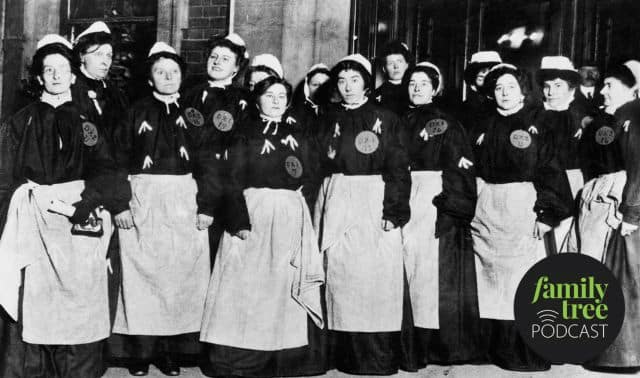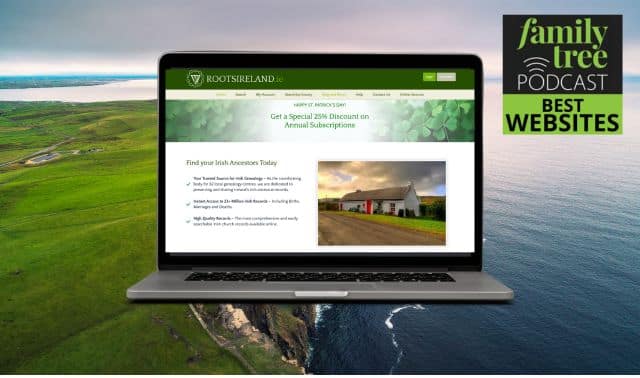Sign up for the Family Tree Newsletter! Plus, you’ll receive our 10 Essential Genealogy Research Forms PDF as a special thank you.
Get Your Free Genealogy Forms
"*" indicates required fields
To find your own ancestors’ motivations for moving on and to begin tracing their migration, Whitaker of RoadTrails advises that you start by working backwards in time—look for clues to a family’s origins at the last destination where you can positively locate them. Then follow these steps to try to puzzle out how they got there:
- Learn the local history and geography. Local histories can document patterns that may explain your family’s move. My hometown of Kearny, NJ, for example, drew large numbers of Irish and Scottish immigrants to work in its textile and linoleum industries. Similarly, silk mills in Paterson, NJ, attracted skilled workers from Poland. Incorporate any local history details into your timeline that may explain the movement of groups of people that might have included your ancestors. Also ask your local public library about 19th-century books and pamphlets used to entice immigration and financial development, Hadden advises. My hometown published a booklet in 1895 to lure New York City businessmen to the bucolic setting of suburban New Jersey.
- Identify boundary line changes in counties and states. Map aids such as the US Geological Survey’s Geographic Names Information System at mapping.usgs.gov/www/gnis/ can help you find place names used on USGS topographical maps, especially where location names and boundaries may have changed. Named places, including some schools and family cemeteries, can be identified from this system. Also check out one genealogy buff’s method of finding US locations using online aerial photos and topographical maps at www.cswnet.com/~sbooks/genealogy/html/topo.htm.
- Use historical maps. The US Geological Survey, state history maps and other resources let you follow the path of your ancestors. William Dollarhide, in his book Map Guide to American Migration Routes, 1735-1815 (Heritage Quest, $9.95), advises, “Get a good map and trace the old migration routes with the modern highways of today. Find the counties that the routes pass through, and make a list of the places where an ancestor may have stopped en route to a final destination.”
- Create your own map. Show the junctions of families through marriage along with their places of origin and their subsequent moves. Your own “map” may be a simple chart on paper, a tracing-paper overlay on a printed map, or a slick creation using one of the many mapping-software programs.
- Create a timeline. Who was where when? To keep track, document your family’s movement, indicating significant events by date and location. Incorporate any local history details into your timeline that may explain migrations. Your regular genealogy software program may be able to create timelines for you; see page 58 for instructions on how to do this with Family Tree Maker and Generations. You may also want to use timeline software such as Genelines (Progeny, $29.95) or The Genealogy Timeline (Computer Management Corp., $49.95) to put your family’s history into a broader context. (See the April 2001 issue of Family Tree Magazine or It’s About Time for a complete review of Genelines.)
Be sure to make use of migration records by following these steps:
- Locate and research records. Find your families in state and federal censuses, in church records, military records and courthouse records. Census records give you insightful information in two ways: they can identify place of birth and, if you don’t find your ancestors in the same place in the next census, that can tell you there’s a good chance they moved. (See the December 2000 issue of Family Tree Magazine for more on census and other federal records.) Check church records where your family settled or may have stopped for any related birth, marriages or deaths. Military records can include service records (such as musters, rolls, rosters, enlistments, discharges, prisoners of war and burials) and pension records. Two sources to help you locate military records are James C. Neagles’ US Military Records: A Guide to Federal and State Sources, Colonial America to the Present (Ancestry, $39.95) and the Family History Library’s research outline (see www.familysearch.org, click Research Helps under the Search tab, hit U and scroll down to US Military Records). You’ll also find clues in local courthouse records, such as deeds, probate and legal proceeding records and documents.
- Pay attention to names. Many families traveled with their neighbors and relatives. They may have started out together or come together by marriage en route. Document the names of witnesses on records and recipient names of personal correspondence.
- Find written accounts. As George Morgan points out in the Genealogy Forum News at www.genealogyforum.rootsweb.com/gfnews/, “As they migrated from one place to another, our ancestors sometimes left written accounts behind. Sometimes they kept journals. More often they wrote letters back to family and friends.” These letters may have described the migration experience, means of travel, the places they saw and the people they met or traveled with. Maybe your family has such sources. If not, look for written accounts by others whose migrations parallel those of your ancestors. Books such as Lillian Schlissel’s Women’s Diaries of the Westward Journey (Schocken Books, $14.95) or Kenneth Holmes’ Covered Wagon Women: Diaries and Letters from the Western Trails, 1840-1849 (University of Nebraska Press, $11.70) provide excellent examples.
- Study the trail itself. Choose a trail or road with special significance to your heritage and seek information from many sources—books, periodicals, videos, television documentaries, museums and the Internet. Check with local historical societies, museums and libraries along the trail to learn more. You may even want to travel the route yourself to get a feel for your ancestors’ experience. Your family’s history, after all, isn’t just a record of names and dates. If you’re like most Americans, it’s also a saga of places. The more you can connect with those places from your past, the better you’ll understand how you got here today.
ADVERTISEMENT




